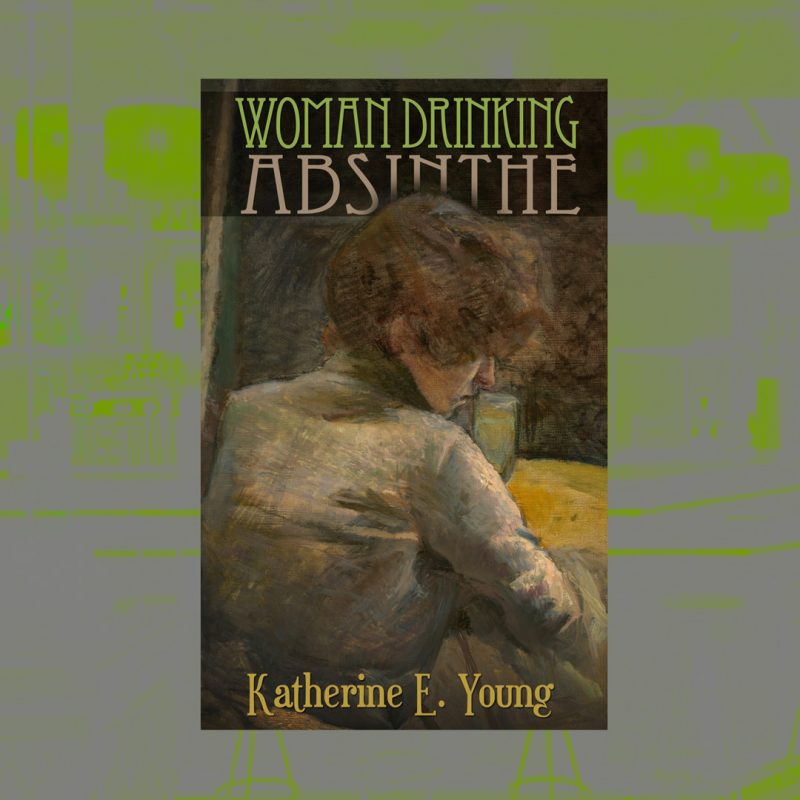USEREVIEW 027: Women Talking Absinthe
Lannie Stabile daydreams a strange and aureate bar-side interview with the eponymous woman of Katherine E. Young’s most recent poetry collection, Woman Drinking Absinthe (Alan Squire Publishing, 2021) in this conversational experimental review.
ISBN 978-1-942892243 | 72 pp | $20.99 CAD
#CAROUSELreviews
#USEREVIEWEDNESDAY
Normally, when I interview authors, I like to meet them in a quiet cafe, treat them to their preferred coffee or tea. Drinks in a dark, local bar seemed more fitting, however, to meet Woman Drinking Absinthe. The atmosphere here is more hole-in-a-tropical-mountainside than hole-in-a-wall. She wears a grey dress, pinned hair, and a tight frown. We pull up two scuffed wooden chairs to a scuffed wooden table. A waiter in a navy-blue dress shirt takes our order and is back with two glasses of absinthe within minutes. I pull out a beat-up notebook and my favourite ball-point pen and we start.
LANNIE STABILE: First of all, let’s toast. To this meeting, to your new book, to your past, present and future successes.
We each lift our lowballs, clink delicately and sip the green liquor. It has a tangy, licorice flavour and, to be honest, I am not a fan.
What do you think of the absinthe?
WOMAN DRINKING ABSINTHE: I’ll savour this love whole, run my lips along its rim, swallow juices, rind, pips, drink in each drop as if it’s the last. It tastes like tea brewed by your wife.
A bit on the weak side then. Let’s get into the questions about writing, shall we? When did you know you wanted to be a muse?
Perhaps it begins in Egypt, heralded by thunderbolts: things that fall from the sky always have meaning. Perhaps it begins when an unknown force slams into Mars, blasting that rock out into space.
Could you describe the process of being written for me?
It starts with the scent of lavender as she buttons clean pantaloons, laces up stays, smooths her bodice and shakes out the frills, ties the black ribbon about her neck. “Emotion” and “flow” are your middle names. The doctors peel my flesh, expose the bone, saw it smooth. Working in layers, they mold muscle, snug up tissue to cushion the stump, snip skin in overlapping flaps exactly the way you’d wrap a present.
Do you find it challenging being a dream a writer once had, and, perhaps, continues to have?
I’d live better with a chain. Tomorrow at dawn our loved ones will break down the door, parade the bloodstained sheets through town.
She takes a moment to comment on the soft jazz uncharacteristically floating in from the bar speakers.
Stroke my WDAs, pluck my catgut strings, blow Coltrane through my bones.
We listen to the end of the song, then jump back into the interview. Woman Drinking Absinthe has places to be, and I don’t want to keep her longer than necessary.
Who or what would you say has influenced your creation the most?
The woman at the counter who startles from her magazine when I rattle the screen. All the cars missing along the highway. Laundry in the dryer, dirty cups beside the sink. The kitchen fire that flared three houses down.
Now, let’s talk about the book that Katherine E. Young wrote, inspired by you, Woman Drinking Absinthe. Can you describe this collection in your own words?
A cat rattles the blinds, thumps across your chest, bats at your eyelids. How many men will eat my fruit, meditate for years beneath my banyan bones?
That’s a beautiful summary. I have to say, my favourite poem in the collection is “The Bear.” I imagine the bear is a metaphor for the men we keep returning to. Has there been a special bear in your life over the years, or is this more of an amalgam?
My cats sniff anxiously, note the bitter tang of bear on my skin. The bear marauds inside my garden, plants his tracks among the roses, says: “I’m not dangerous! Let me make a den for you.” When he holds me in his arms, I hear roaring in my ear, “Does he know to smooth your cheek with all his claws drawn in?”
Your story, if you will, is told from multiple women’s perspectives. Love poems coming off a late-night bender. Whom do you think might benefit the most from reading this book?
People who don’t know each other well but mean to and aren’t so sure of the rules anymore. The woman who counts her devotion in grains of salt.
Do you feel you may inspire further works of poetry or show up in the consciousness of other artists?
The words vibrate along your inner string, resonate strong and clear before dissolving to birdsong: shriek and whistle, careless click-clack of beaks, the shaping of the empty air.
Thank you again for taking time to do this. I’ve gained incredible insight into a book I was already half in love with. So, thank you, thank you, thank you. If you don’t mind, I’d like to end with one last question I always like to ask: If you were a llama, what kind of formal poem would you write?
A parable of the fig tree: when the branch is tender and putteth forth leaves.


